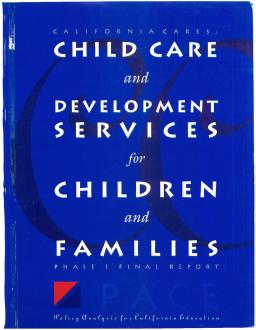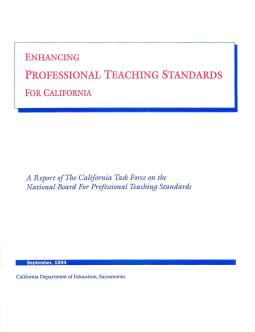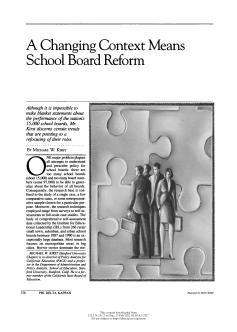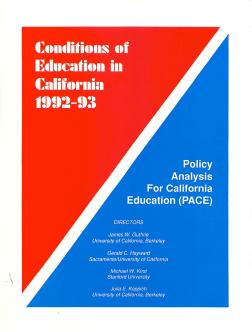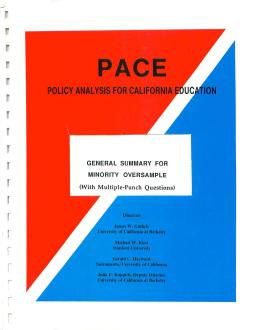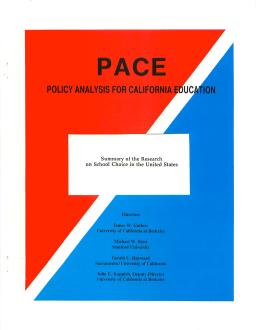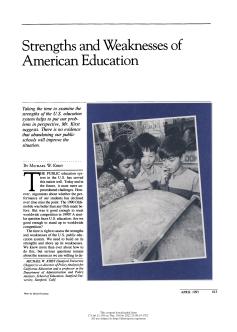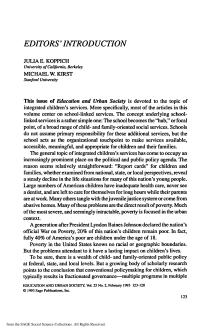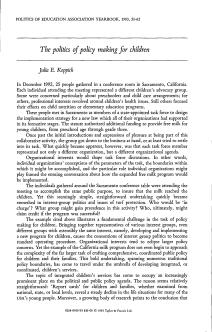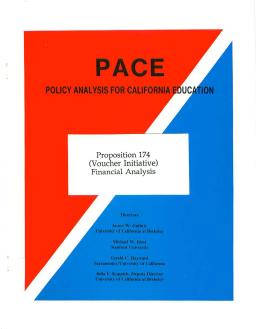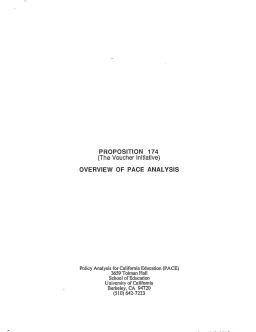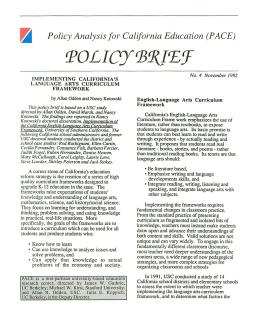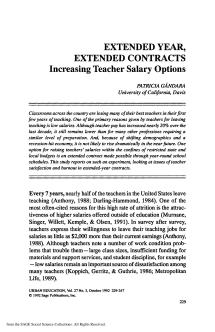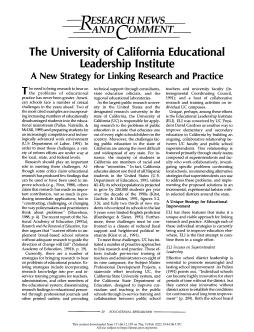Child Care and Development Services for Children and Families—Phase I Final Report
Published
Summary
The California Department of Education, Social Services, and Governor's Office of Child Development and Education selected PACE to analyze issues and options for improving California's childcare system. PACE will produce a report with optional approaches for improving access, quality, and funding of childcare services, including alternative systems and policy models. Phase I includes analysis of childcare issues and programs, literature reviews, and experiences of other urban states. This report summarizes Phase I's work.
Published
Summary
This is the ninth edition of Conditions of Education in California. In this volume, PACE has compiled information on current critical issues in state education policy and presented them within the context of major policy developments. "Evolving Context" introduces the current issues in the state and sets the stage for the remaining chapters, which are Assessment and Achievement, Finance, Teachers and Teaching, Integrated Children's Services, Child Care and Development Services, and School-to-Work.
A Plan for California’s Schools
Published
Summary
In 1990, PACE issued a plan for CA schools, addressing the challenges of explosive growth, increasing diversity, and lagging student achievement. Five years later, PACE has revised the plan to include measurable statewide education goals, a new student assessment system, teacher education reforms, and the goal of English proficiency for all students. Other recommendations include school finance reform, coordination between schools and social services, evaluation of local reform efforts, experiments to improve student achievement, and linking school-to-career policy with education reform.
A Report of the California Task Force on the National Board for Professional Teaching Standards
Published
Summary
The California Task Force on the National Board for Professional Teaching Standards, consisting of educators, administrators, parents, and officials, deliberated for eight months on how a national voluntary certification system can impact California's education landscape. They explored questions on the standards, assessment methods, incentives, and potential benefits for teachers, students, and communities. The report aims to start a dialogue and encourage continued improvement in California's schools.
Published
Summary
The National Science Foundation granted MIT's Jerold Zacharias in 1956 to develop a real science physics curriculum for high school students. By the 1970s, curricula were developed in various sciences, but each independently with differences in development, planning, and concepts. Despite the $117 million cost, adoption rates peaked and momentum for further curricula development waned. Lessons can be drawn from this experience to inform national standards today.
Published
Summary
The research base for understanding and prescribing policy for school boards is limited due to the large number of boards and members. Common school boards, especially those of small districts, are less researched. To address this, overall trends affecting most boards should be analyzed to determine the need for and direction of school board reform. Waiting for representative data on all boards will delay improvements to policy making. Major changes in school board roles, functions, and operations are necessary due to the interaction of these trends.
Published
Summary
PACE's Conditions of Education in California 1992-93 volume is the eighth edition and marks PACE's tenth anniversary. The report provides neutral, objective, analytic data on California's education system, analyzing data on enrollment trends, student achievement, fiscal conditions, human resources, education governance, and the politics of education. The report includes a chapter on education reform, an opinion poll on Californians' perceptions of the education system, and critical data on enrollment and fiscal trends, student achievement, and school governance.
Published
Summary
This report provides an overview of private schools in California as of 1992–1993, examining their enrollment, types, size, geographic distribution, and regulatory environment. It also considers how existing private schools might respond to increased demand if Proposition 174 —a school voucher initiative—were enacted. Under Proposition 174, private schools enrolling 25 or more students and meeting existing legal requirements could redeem vouchers for tuition payments. Private schools enrolled nearly 10 percent of California’s K–12 students, with approximately 554,000 students attending 3,839...
(With Multiple Punch Questions)
Published
Summary
General Summary #2660 – California/Minor – 9/93
Published
Summary
PACE conducted a poll of over 1,400 Californians to understand public opinion on education and school vouchers. The poll explored what Californians want in their schools, attitudes towards vouchers and trade-offs, and satisfaction with public and private schools. The study analyzed differences among Californians by race, socio-economic status, religion, region, and more. Conducted by Penn & Schoen Associates, the poll provides a snapshot of public opinion to aid voters, parents, educators, and policymakers in understanding potential new directions for improving education.
Published
Summary
The paper provides a synthesis of existing literature on school choice, with a focus on research that informs public policy development and evaluation. It presents information without taking a position for or against school choice and is intended for policymakers, parents, educators, and the public. The paper covers six sections, including types of school choice programs, efficacy, economic theories, private schools, public opinion, and unresolved research questions.
Published
Summary
The US public education system has served the nation well, but it must now face unprecedented challenges and worldwide competition. The strengths and weaknesses of the system need to be assessed to build on its strengths and address its weaknesses. However, questions remain about the resources and political will necessary to get the job done.
Published
Summary
The article discusses the importance of parent involvement in education and its effects on student achievement. It suggests that schools need to create a welcoming environment for parents and engage them in meaningful ways, such as through volunteering and decision-making committees. Additionally, the article emphasizes the need for schools to provide information and resources to parents, especially those who are disadvantaged, to ensure that they are equipped to support their children's learning at home.
Editors' Introduction
Published
Summary
The concept of school-linked services is to make social services available to children and families through the school acting as an organizational touchpoint. This idea has become increasingly prominent due to the declining life situations of many American children, particularly those in urban areas, who face poverty-related issues like inadequate healthcare, juvenile justice involvement, and abusive homes.
Published
Summary
The politics of policy making for children is complex due to the multiple interest groups involved. Fragmented policies exacerbate the problem of declining life situations for children. A comprehensive children's policy is needed, but traditional interest-group approaches to policy development must shift to integrate services for children. California's politics of children's policy is briefly explored. The current political paradigm must fundamentally change to open policy doors for broad-based integrated services for children.
Financial Analysis
Published
Summary
The Californians will vote on Proposition 174 which will amend the state constitution to establish "scholarships" for kindergarten to 12th-grade schooling. These new schools will be publicly funded but may have privately selected governing boards and religious orientation. It is unclear whether they will be public or private schools. The paper attempts to reduce uncertainty regarding the financial consequences of the proposed voucher plan and address questions about public costs and possible cost savings.
Overview of PACE Analysis
Published
Summary
Policy Analysis for California Education (PACE) has analyzed the financial, legal, and social ramifications of Proposition 174, the school choice initiative, to provide Californians and policymakers with accurate, unbiased information. This brief contains important questions and answers about the initiative, summaries of PACE's financial analysis and polling report, and background information on PACE and its directors. PACE has published five separate analyses of Proposition 174, covering financial impacts, legal considerations, public opinion, and comparisons with other school choice efforts...
The School Voucher Initiative
Published
Summary
The "Parental Choice in Education Initiative" or Proposition 174, will be voted on by Californians on November 2, 1993. PACE has conducted an analysis of the initiative's provisions to provide objective information to policymakers, parents, educators, and the public. PACE is not taking a stance on the initiative but has produced additional materials related to the initiative and the issue of school choice. These materials are listed in the attached report on school choice.
Published
Summary
California's education reform strategy includes creating high-quality curriculum frameworks to upgrade K-12 education, which raise expectations for students' knowledge and understanding of language arts, mathematics, science, and history/social science. The frameworks focus on learning for understanding, problem-solving, and applying knowledge to real-life situations. The goals are to produce students who know how to learn, analyze issues, solve problems, and apply their knowledge to real-world problems.
Increasing Teacher Salary Options
Published
Summary
Many new teachers leave the profession due to low salaries, which have only slightly increased despite requiring similar preparation to other professions. A possible solution is extended contracts made possible by year-round school schedules, which could raise salaries within restricted budgets. This study examines the effects of extended-year contracts on teacher satisfaction and burnout.
A New Strategy for Linking Research and Practice
Published
Summary
The US faces critical challenges in education, such as incorporating disadvantaged students and preparing them for a competitive, tech-driven work environment. To meet these challenges, reform efforts are underway. Despite claims that educational research has produced few applicable findings, it has contributed by changing how policymakers and practitioners think about problems. The National Academy of Education argues that implementing broad-based reforms without adequate research will fail. Research must play an important role in meeting these challenges.
Published
Summary
California's public school student achievement is improving but still has a ways to go to meet world class standards. Increasing enrollments, declining revenues, and political issues are distracting from education reform. This policy brief seeks to bring attention to building public visibility and political consensus around national strategies for accelerating education reform. The message is not that California's public education system will be subordinated to a monolithic national reform effort.
Lessons from the California School Leadership Academy
Published
Summary
American education reform stresses the importance of principals as instructional leaders, but most are not effective in this role. Research suggests that innovative administrator training is needed to transform the role of site administrators. Content and process criteria have been identified, and several state-sponsored training programs have been established to meet them. One such program is the California School Leadership Academy, which provides a three-year program for aspiring and practicing site administrators with an emphasis on instructional leadership.
Published
Summary
The seventh edition of Conditions of Education in California by PACE focuses on education policy issues in a national context. The report analyzes California's education data by placing it in multi-state, national, and international contexts. The report's first three chapters analyze evolving education policy issues, Sacramento political dynamics, and student achievement. The remaining three chapters provide longitudinal data on student enrollment, finance, and system characteristics. The report aims to provide a continuing picture of education in California.
What Schools Must Do
Published
Summary
This article contends that school-linked services and education reform efforts are integrally related. Successful implementation of school-linked services requires new roles and responsibilities for all levels of school personnel. Drawing on general experience and citing specific examples from the New Beginnings experience in San Diego, the article outlines these new roles and responsibilities for school superintendents, board members, principals, and teachers. It describes the planning process involved, a process that includes an initial feasibility study and community needs assessment; a...
